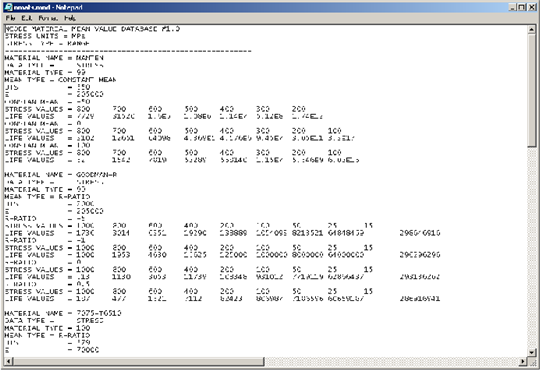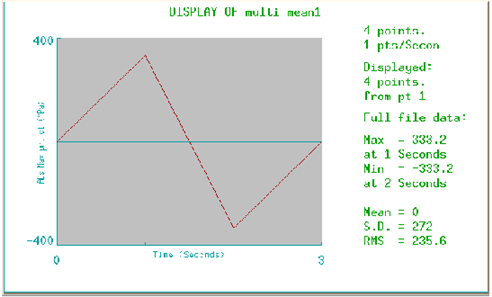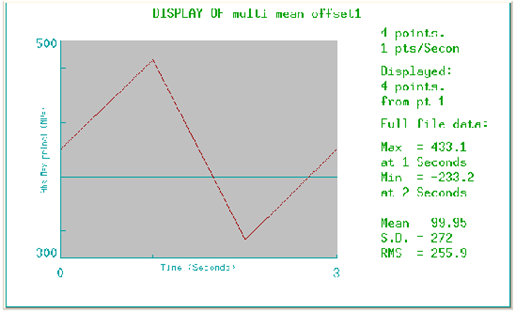XXXXXXXXXXXXXXXXXXXXXXXXXXXXXXXXXXXXXXXXXXXXXXXXXXXXXXXXXXXXXXXXXXXXXXXXXXXXXXXXXXXXXXXXXXXXXXXXXXXXXXXXXXXXXXXXXXXXXXXXXXXXXXXXXXXXXXXXXXXXXXXXXXXXXXXX''"> Multiple Mean Stress Curve Support
This section describes the multiple mean stress curve support in MSC Fatigue.
Multiple mean stress curve analysis uses empirical data to account for mean stress effects rather than analytical methods such as Gerber and Goodman.
Multiple mean stress curve analysis is for S-N analysis only. Temperature corrections, certainty of survival, Optimization and Fast Analysis are not available for Multiple Mean Stress Curve S-N analysis.
Set Up the Fatigue Analysis
We will use the model in the previous exercise to run this test case. Leave all settings on the general setup form as is except for the Jobname and the Title. Set these as shown:
1. Jobname: multi_mean
2. Title: Multiple Menu Stress Curve
Solution Parameters
Open the Solution Params form. Set the Mean Stress Correction optionmenu to Multiple Mean Curves. Use the default values for all the other widgets. Click OK to close the form.
Material Information
Open the Material information form. It is identical to the standard S-N analysis, except:
• An ASCII materials database is used (extension .mnd) instead of the standard Materials database (.mdb).
• Selecting the Materials Database Manager button brings up a text editor instead of PFMAT.
• Even though the Surface Finish, Treatment and Kf cells are visible they are not available for input.
Click on the Materials Database Manager button to view the file containing the Multiple Mean Stress Curve data.
Select the Material M ANTEN from the listbox and pick the default_group for analysis. Click OK.
Loading Information
Open the Loading information form. This form should be still filled out from the previous example. Click OK to accept the inputs.
Run the Fatigue Analysis
Open the Job Control form. Set the Action to Full Analysis and click the Apply button. Monitor the job and once it has completed close the form. Open the Results form. Set the Action to List Results and click Apply. The PFPOST module is now displayed. Select the Jobname multi_mean and click OK. Accept the defaults on the next form by just clicking OK. Now select the detail Information switch. The form that is displayed shows that a life of 1.86E4 repeats, read off the zero mean MANTEN curve, is reported at Node 1. Click End to close the form. Press eXit to exit the PFPOST module.
Lets take a closer look at the stress time history at this node. In order to do this the Action needs to be changed to Extract Time History. Enter Node 1 in the databox and press Apply. The MFATFE module is now displayed. On the first form select the Utilities switch. Next select the Node/Element options switch and click OK. On the next form click OK to accept the Result Filename, then select the User input switch and set the Node/Element ID to 1. Click OK. Select the Time History Extraction switch and click OK. This will bring up a table that shows the maximum and minimum stress values for Node 1. Press Cancel to close this form and bring up the graphical representation of the data as shown below.
To close this picture select File | eXit. Select Return, then select return to Main menu, and finally select eXit to close the MFATFE module.
Make a note of this life as we will compare this life with and offset time history to demonstrate the Multi Mean Stress Curve concept.
Verification: On the General Setup form, change the Jobname to multi_mean_offset. Offset the Time History on the loading form by applying an offset of 0.3 that will yield an offset range mean of 100 Mpa. A 100 Mpa mean stress S-N curve exists in the database for MANTEN, the material used in the analysis above.
Run the Job and list the results. The life at the same location (Node 1) drops to 2.3E3 repeats. The offset stress time history at Node 1 is shown below.
For a stress range of 666 Mpa, the 100 Mpa mean stress curve yields the life calculated.





